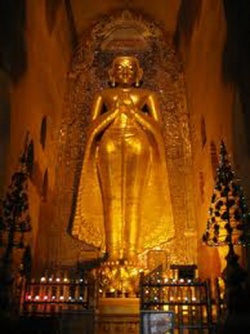Difference between revisions of "Fa-yün"
(Created page with "thumb|250px| <poem> '''Fa-yün''' [法雲] (PY Fayun; Jpn Houn) (1) (467-529) A priest revered as one of the three great Dharma teachers of China'...") |
|||
| (4 intermediate revisions by 3 users not shown) | |||
| Line 1: | Line 1: | ||
[[File:Ananda-ges.jpg|thumb|250px|]] | [[File:Ananda-ges.jpg|thumb|250px|]] | ||
<poem> | <poem> | ||
| − | + | [[Fa-yün]] | |
| − | [法雲] (PY Fayun; Jpn Houn) | + | [[法雲]] (PY [[Fayun]]; Jpn [[Houn]]) |
| − | (1) (467-529) A priest revered as one of the three great Dharma teachers of China's Liang dynasty, the others being Chih-tsang and Seng-min. He joined the priesthood in 473 and studied under Seng-yin. He gained renown with his lectures on the Lotus Sutra and the Vimalakirti Sutra in 496, and in 508 Emperor Wu appointed him chief priest of Kuang-che-ssu temple. The emperor often invited him to lecture at court. Emperor Wu built Fa-yün-ssu temple for him in 519, and in 525 Fa-yün was appointed general administrator of priests, the highest rank in the priesthood. He also wrote a commentary on the Lotus Sutra titled The Meaning of the Lotus Sutra. | + | (1) (467-529) A priest revered as one of the three great [[Dharma]] [[teachers]] of [[China's]] [[Liang dynasty]], the others {{Wiki|being}} [[Chih-tsang]] and [[Seng-min]]. He joined the priesthood in 473 and studied under [[Seng-yin]]. He gained renown with his lectures on the [[Lotus Sutra]] and the [[Vimalakirti Sutra]] in 496, and in 508 [[Emperor Wu]] appointed him [[chief priest]] of [[Kuang-che-ssu]] [[temple]]. The [[emperor]] often invited him to lecture at court. [[Emperor Wu]] built [[Fa-yün-ssu]] [[temple]] for him in 519, and in 525 [[Fa-yün]] was appointed {{Wiki|general}} [[administrator of priests]], the [[highest]] rank in the priesthood. He also wrote a commentary on the [[Lotus Sutra]] titled The Meaning of the [[Lotus Sutra]]. |
| − | (2) (1087-1158) A priest of China who compiled A Dictionary of the Pronunciation and Meaning of Buddhist Terms, a | + | (2) (1087-1158) A priest of [[China]] who compiled A {{Wiki|Dictionary}} of the Pronunciation and Meaning of [[Buddhist]] Terms, a [[Sanskrit]]—[[Chinese]] [[Buddhist]] {{Wiki|dictionary}}, in 1143. He is said to have spent some twenty years compiling the text. He also lectured on the [[Lotus]], [[Golden Light]], [[Nirvana]], and [[Vimalakirti sutras]]. |
</poem> | </poem> | ||
{{R}} | {{R}} | ||
Latest revision as of 23:20, 6 February 2014
Fa-yün
法雲 (PY Fayun; Jpn Houn)
(1) (467-529) A priest revered as one of the three great Dharma teachers of China's Liang dynasty, the others being Chih-tsang and Seng-min. He joined the priesthood in 473 and studied under Seng-yin. He gained renown with his lectures on the Lotus Sutra and the Vimalakirti Sutra in 496, and in 508 Emperor Wu appointed him chief priest of Kuang-che-ssu temple. The emperor often invited him to lecture at court. Emperor Wu built Fa-yün-ssu temple for him in 519, and in 525 Fa-yün was appointed general administrator of priests, the highest rank in the priesthood. He also wrote a commentary on the Lotus Sutra titled The Meaning of the Lotus Sutra.
(2) (1087-1158) A priest of China who compiled A Dictionary of the Pronunciation and Meaning of Buddhist Terms, a Sanskrit—Chinese Buddhist dictionary, in 1143. He is said to have spent some twenty years compiling the text. He also lectured on the Lotus, Golden Light, Nirvana, and Vimalakirti sutras.
